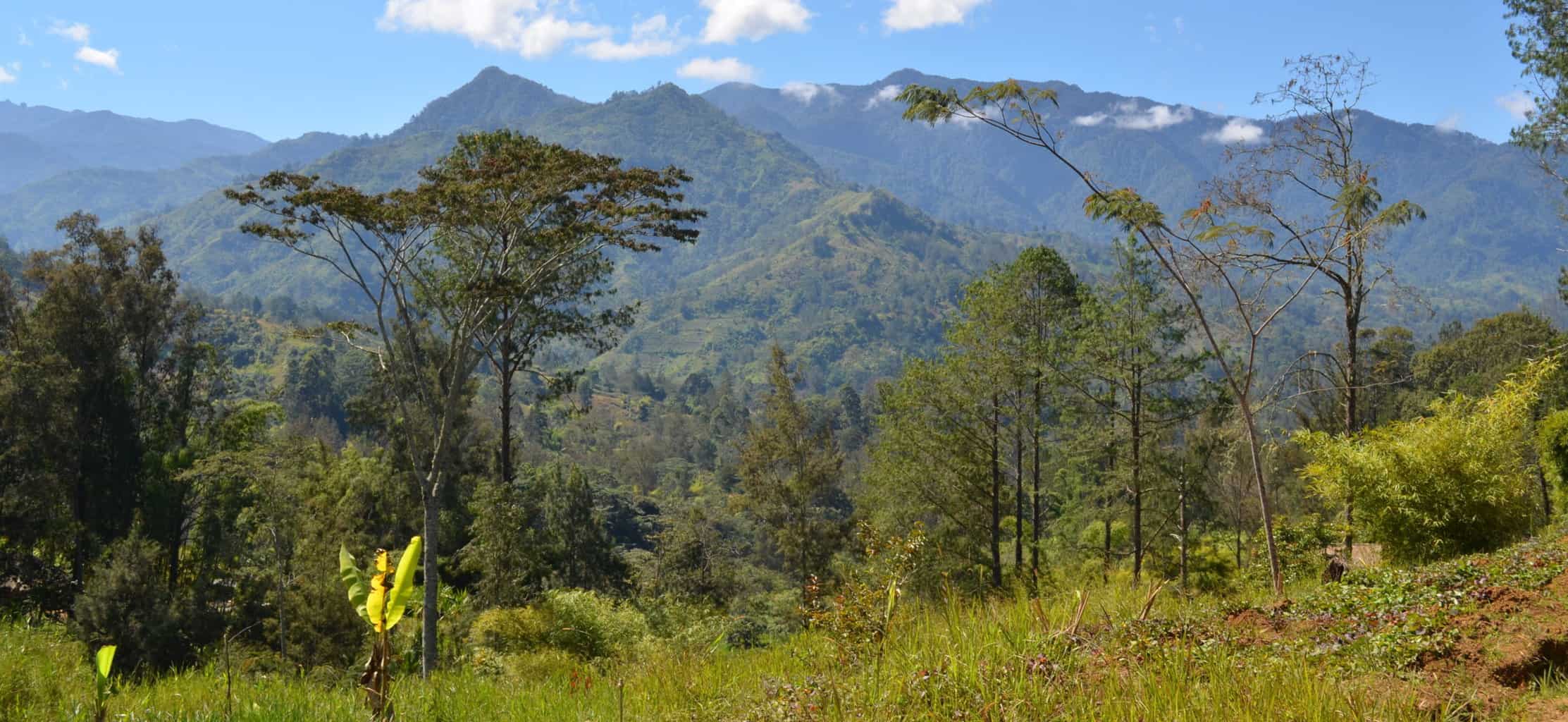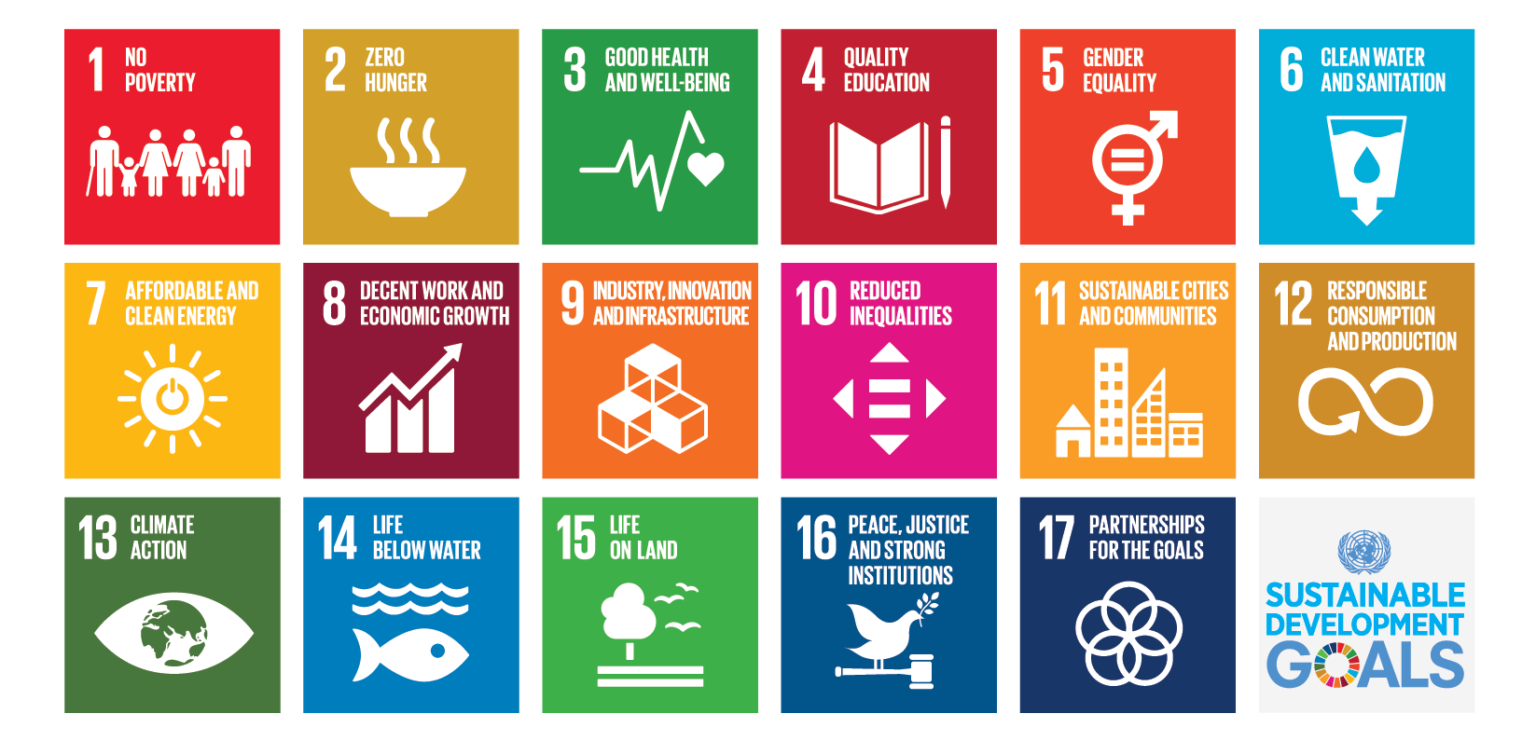Papua New Guinea, rich in resources, still struggles to fulfil its people’s human rights
By HRMI Researchers Livvy Mitchell and Natalie Speier.
The Human Rights Measurement Initiative (HRMI) is the first global initiative to track the human rights performances of countries. This country profile focuses on the economic and social rights outcomes for Papua New Guinea. All data discussed below are available on our Rights Tracker. See also HRMI’s Research credentials. You are welcome to use and quote from this article with attribution. This country spotlight refers to data published in 2020.
Papua New Guinea is home to immense natural resources, including unique biodiversity and vast mineral deposits. However, PNG is struggling to translate its great natural wealth into the better enjoyment of economic and social rights for its people.
The Papua New Guinean government has made significant legislative changes in recent years to bolster its respect of human rights. For instance, PNG passed the Family Protection Act in 2013, which criminalises domestic violence and provides a framework to combat violence against women.
Papua New Guinea is struggling to translate its great natural wealth into the better enjoyment of economic and social rights for its people.
In terms of economic and social rights, PNG has also made efforts to increase access to healthcare and education. The government developed a National Health Plan which aims to improve primary care and make medical care more accessible to all citizens.
To reach the country’s goal of universal primary education, PNG introduced a Tuition Fee-Free policy in 2012 which allowed students to attend school free of charge. As a result of this policy, enrolment in basic education nearly doubled in 2014.
While the government continues to take steps towards improvement, critical changes must be made if Papua New Guineans are to enjoy their human rights to the fullest possible extent.
Despite improvements like these, large barriers to education, healthcare, and other quality of life rights remain.
PNG’s progress is greatly hampered by on-going government corruption and economic mismanagement. Nearly 40% of PNG’s population live in poverty; close to a quarter of children in PNG do not attend school; and the country’s underfunded healthcare system leaves 1 in 13 children vulnerable to death from preventable diseases. Access to nutritious food also remains an issue as evidenced by the large number of children experiencing stunted growth due to malnutrition.
While the government continues to take steps towards improvement, critical changes must be made if Papua New Guineans are to enjoy their human rights to the fullest possible extent.
The Human Rights Measurement Initiative (HRMI) uses award-winning methods to learn what improvements are possible within a country’s limited income. Some headlines from this article:
- If PNG were operating at its full potential given its current resources, it would lift 4 million people out of poverty and make significant steps toward SDG 1 of eliminating extreme poverty by 2030.
- If PNG were to use its resources efficiently, 380,000 more children under five could avoid stunting, and make significant gains toward SDG 2’s target of ending starvation by 2030.
- If PNG were operating at best practice, 38,000 more children would have a much better chance of reaching their fifth birthday, contributing to SDG 3’s target of ending preventable deaths of children under five by 2030.
- If PNG were operating at best practice, an extra 180,000 children would be enrolled in primary school.
- If PNG used its resources efficiently, an additional 7 million people would have access to basic sanitation and an extra 6 million people would have access to water on site.
In this article you can read every section, to understand HRMI’s data in detail, or skip to the PNG-specific sections, for some examples of how PNG’s change-makers can use our data to work for human rights improvements.
How do HRMI’s data work?
HRMI data can help boost efforts to improve people’s lives in PNG by giving definitive scores measuring government performance on economic and social rights outcomes. Each rights score can then be used to show where change is needed most and how these changes can be achieved.
So, how does HRMI work? HRMI’s ground-breaking methodology allows us to score countries on how well they use their income for economic and social rights (ESR) outcomes. In particular, our current data focus on the rights to food, health, housing, work, and education. To calculate a country’s ESR scores we use the SERF Index methodology, developed by HRMI co-founder Susan Randolph and her colleagues Sakiko Fukuda-Parr and Terra Lawson-Remer.
The SERF Index combines country achievement and country income to produce a ‘best practice’ benchmark that records the best results that any country has achieved over the last 20 years, at every income level. Each country’s current achievement level is then compared to the best practice outcome for its income level and given an ESR score as a percentage of that result. So any score that’s less than 100% is showing that there’s a gap between how that country is doing, and the best result of any other country with the same level of income.
The ESR scoring methodology takes income into account, so it can assess all countries on a level playing field. It can then be used to reveal how a country can improve its rights performance, and by how much, even without more income or resources.
When a country scores 100% on the performance of a right, it means that the government is keeping its human rights promises to do its very best for its people within the constraints of the country’s resources. All countries can score 100%. Any score below 100% shows that there is realistic room for improvement, even at the country’s current level of resources. An underperforming country can use HRMI’s ESR scores to see which of their nearby countries are doing better and identify policy lessons from them.
There is a lot of cross-over between HRMI’s human rights performance indicators and the UN’s Sustainable Development Goals (SDGs) targets and benchmarks. Countries can use HRMI’s scores to evaluate their own progress and their potential to reach the 2030 Agenda for Sustainable Development, given their current level of income.
HRMI’s benchmarks and assessment standards
HRMI’s methodology uses two benchmarks and two assessment standards when evaluating a country’s ESR performance.
The first benchmark is the ‘income adjusted’ benchmark. Using this benchmark, countries are compared with other countries of a similar income level, allowing us to evaluate how effectively each country is using its available resources. The second benchmark is the ‘global best’ benchmark. This benchmark evaluates country performance relative to the best performing countries at any level of resources.
Both benchmarks are useful for different purposes. The country scores measured against the income adjusted benchmark show how effectively a country is using its resources to achieve good rights outcomes. This also tells us how much its performance can be improved even without extra income. The scores measured against the global best benchmark show how far a country has to go to do as well as any country in the world. These global best scores are important because even if a government is doing its best with their current resources (so it has an income adjusted rights score close to 100%), a country with very low income will likely still have many people not fully enjoying their human rights, which will be reflected in low scores when measured against the global best benchmark.
The assessment standard tells us which collection of rights indicators we use to evaluate the ESR performance of a country. The difference between the two assessment standards is to do with the availability and relevance of data for low and middle income countries versus high income countries.
The low and middle income assessment standard includes rights indicators which low and middle income countries are more likely to have data on, and/or which are more relevant to the rights challenges they currently face. The high income assessment standard includes rights indicators high income countries are most likely to have data on, and/or which are more relevant to the rights challenges they face.
For example, when figuring out how well countries are doing at fulfilling the right to education, for low and middle income countries we look at primary and secondary school enrolment rates. This tells us about access to education. Both indicators are widely available for low and middle income countries and vary widely across them.
But in high income countries, primary school enrolment is essentially universal, so this indicator isn’t a very useful measure of access to education. Instead, for our high income assessment standard we use the secondary school enrolment rate as our single indicator of access, but we also include an indicator of school quality: student performance on the Program for International Student Assessment (PISA) tests. School quality is no less a concern for low and middle income countries, but unfortunately, at this time there is no test of student performance that is widely used by low and middle income countries.
We do produce scores on all indicators for all countries if the data are available. So, for example, you can see HRMI scores related to a low income country’s PISA results if that country participates in the PISA assessments.
It can be useful to toggle between the two assessment standards, and check out our scores on the individual indicators, on the country pages of the Rights Tracker.
HRMI’s data are useful for PNG’s change-makers
Let’s explore the economic and social rights performance of PNG using HRMI’s ESR data. The population of PNG in 2017 was 8.4 million, at which time PNG had a GDP per capita of $3,957 (in 2011 PPP dollars). Therefore, HRMI ESR metrics for PNG are best assessed against the income adjusted performance benchmark using the low and middle income assessment standard.

Right to Food
The right to food relates directly to SDG 2: Zero Hunger, which aims to end all forms of starvation by 2030. PNG’s right to food score is 42.2%, which is based on the percentage of children under five that are not stunted.
We use child stunting as a high-level ‘bellwether’ indicator to reveal how many Papua New Guineans are not getting enough energy and nutrients from their diets to grow normally. (For more on this, please see our Methodology Handbook.)
Data on PNG’s child stunting rate is most recently observed in 2017. At this time, only 56.8% of PNG’s children under five were not stunted. This is PNG’s raw indicator score.
Given PNG’s 2017 income level, it should have been able to ensure that 92.1% of children under five were not stunted. Thus, PNG’s income adjusted right to food score is only 42.2%. This score means PNG is only doing 42.2% of what should be possible with its current GDP per capita to ensure the enjoyment of the right to food.
If PNG were operating at best practice, it could raise its income adjusted right to food score from 42.2% to 100%. In other words, if PNG used their resources effectively even without additional income, it could increase the percentage of children not stunted from 56.8% to 92.1%, resulting in fewer than 8% of children under five being stunted.
If PNG were to operate at its full potential given its current resources, 380,000 additional children under five could avoid stunting, and make significant gains toward SDG 2’s target of ending starvation by 2030.
Comparing this score with other low and middle incomes countries in East Asia and the Pacific, PNG is ranked toward the bottom of the list, along with Timor-Leste and Laos. PNG could look to Tuvalu and Samoa for policy advice on how to improve right to food outcomes as these countries have have an income-adjusted score of 100%.
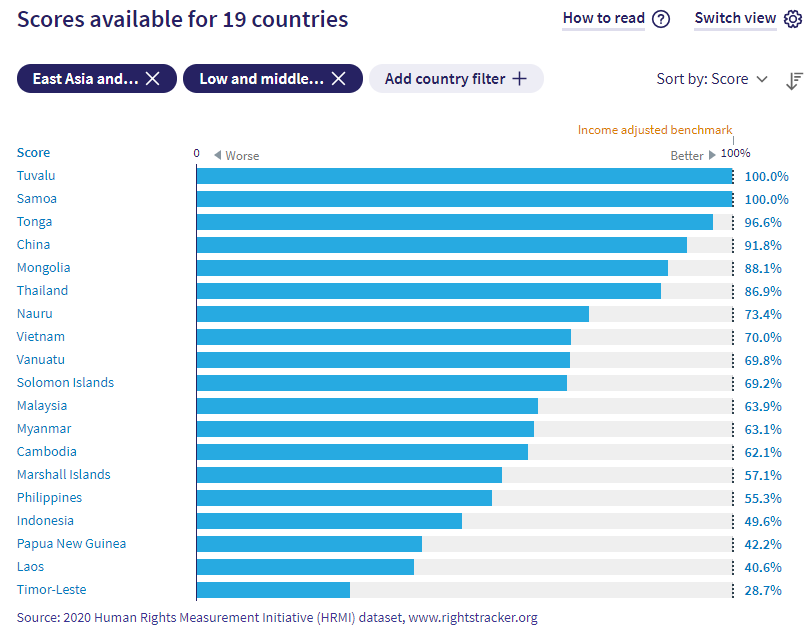
Right to Health
PNG’s right to health score is 69.3%.
As shown in the image below (taken from the PNG page of our publicly available Rights Tracker), this score comes from three indicators: the use of contraception by women ages 15 to 49 years who are married or in-union (score = 39.4%); children surviving to age five (score = 88.5%); and adult survival (score = 80.1%).
On average, these income adjusted indicator scores suggest the extent to which people enjoy the right to health is approximately 69.3% as high as it could be, even at PNG’s current income level.
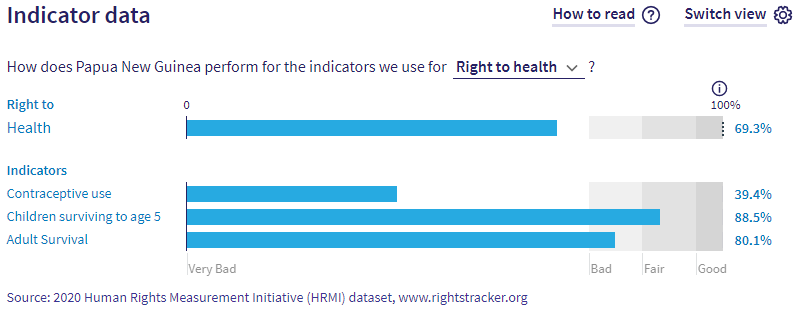
When we line up all low and middle income countries in East Asia and the Pacific in order of their HRMI right to health scores, PNG is ranked 18th out of 20 countries. This tells us that PNG’s policy-makers could look to many of its neighbours with similar incomes, who are doing much better, for examples of ways to make improvements (such as China or Thailand).
When toggling over the indicator scores by sex on the Rights Tracker, we see that PNG females outscore PNG males for both the children surviving to age five indicator (88.2% versus 86.1%) and the adult survival indicator (82.3% versus 79.6%).
These right to health indicators collectively relate to SDG 3: Good Health and Well-being, as well as SDG 1: No Poverty.
If PNG were operating at best practice, approximately 38,000 additional children would have a much better chance of reaching their fifth birthday, contributing to SDG 3’s target of ending preventable deaths of children under five by 2030.
Right to Housing
PNG’s ESR score for the right to housing is 18.4%. As illustrated by the Rights Tracker screenshot below, this score is averaged across two indicators: access to basic sanitation (score = 13.6%), and access to drinking from an improved water source on site (score = 23.3%).
These indicators relate to SDG 1: No Poverty, SDG 6: Clean Water and Sanitation, and SDG 11: Sustainable Cities and Communities.
Based on these income adjusted indicator scores, our analysis tells us that:
If PNG used its resources efficiently, an additional 7 million people would have access to basic sanitation and an extra 6 million people would have access to water in their homes.
Furthermore, compared to other low and middle income countries in East Asia and the Pacific, PNG scores the lowest on the right to housing. Given that many of PNG’s neighbours have income adjusted right to housing scores more than double or triple PNG’s score, this tells us that it is possible for PNG to greatly improve its right to housing performance even without the need for additional income.
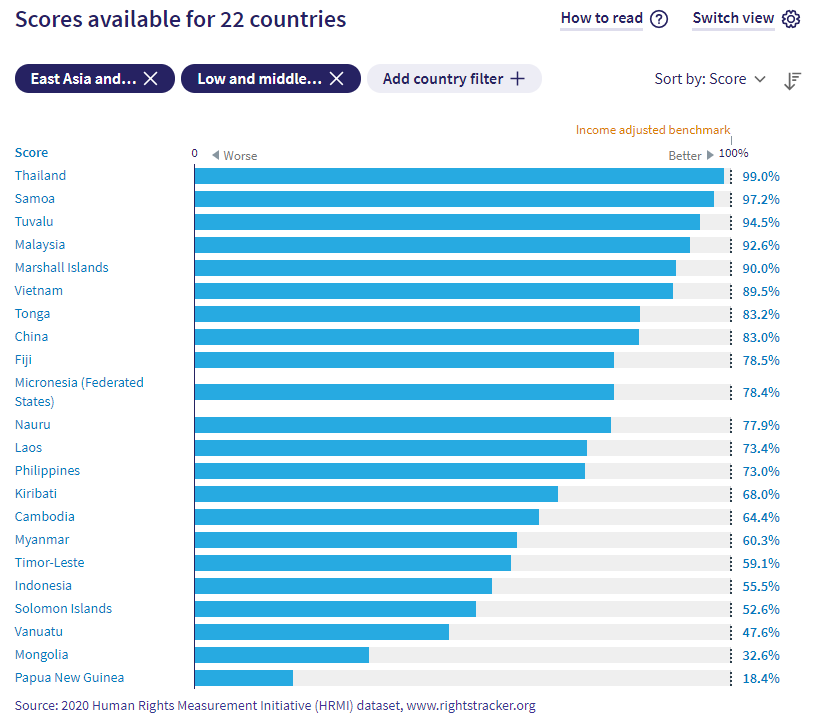
Right to Work
PNG’s right to work score is 38.1%, as measured by the percentage of people not in absolute poverty, where the absolute poverty line is set at $3.20 (2011 PPP$) per day.
This indicator relates to SDG 1: No Poverty and SDG 8: Decent Work and Economic Growth.
This score means PNG is only achieving 38.1% of what should be possible with its current income to ensure the right to work is enjoyed by all.
If PNG were operating at its full potential given its current resources, it would lift 4 million people out of absolute poverty and make significant steps toward SDG 1, eliminating extreme poverty by 2030.
It is important to note that PNG’s right to work data are only available in 2009. Therefore, it is possible that PNG has made improvements on this front since 2009, but there are yet to be credible data sources that can evaluate this potential success.
Right to Education
PNG has a right to education score of 56.8%. This score is comprised of two indicator scores: (1) the total number of students of the official primary school age group who are enrolled at primary school (score = 76.6%); and the total number of secondary school aged students who are enrolled in secondary school (score = 76.6%).
Both these education indicators reflect SDG 4: Quality Education and SDG 1: No Poverty.
PNG’s primary school enrolment indicator score has varied quite substantially over a ten year period. As shown on the graph below, PNG’s primary school enrolment score was 38.6% in 2009, and peaked at 81.2% in 2012.
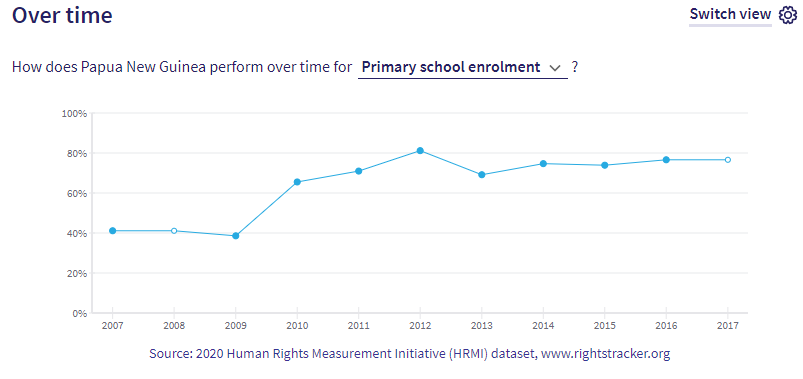
While PNG’s current (2017) primary school enrolment indicator score of 76.6% seems high in percentage terms, HRMI still categorises this score as ‘Bad’ on the spectrum of income-adjusted rights scores. This can be seen on the screenshot below where ‘Bad’, ‘Fair’ and ‘Good’ scores are placed on the grey-scale panels.
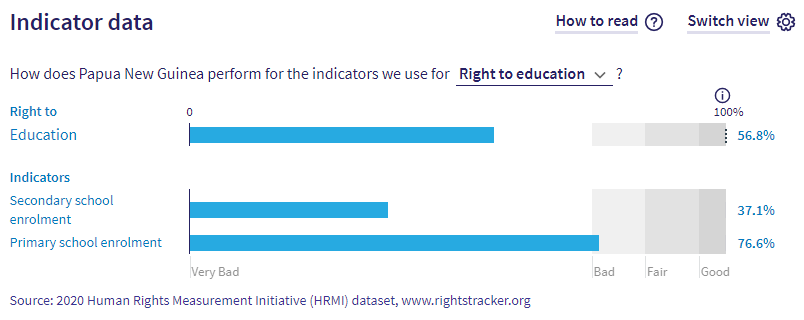
If PNG were operating at best practice, an extra 180,000 children would be enrolled in primary school and an additional 600,000 secondary school aged children would be enrolled in secondary school.
PNG’s overall rights performance
HRMI’s economic and social rights scores for PNG are summarised in the Rights Tracker image below. Across all five rights, PNG has a Quality of Life score of 45.0%.
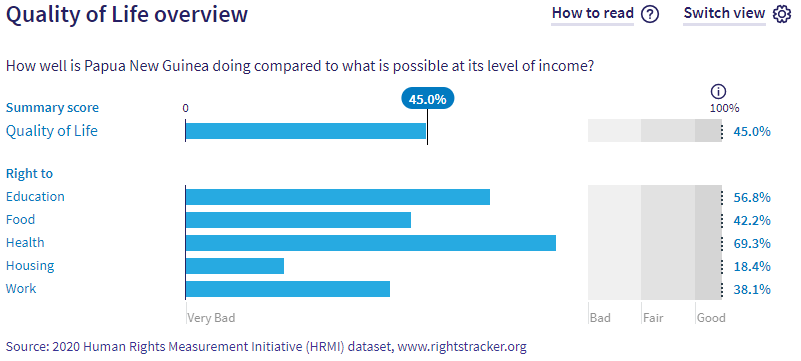
You can compare PNG’s five rights scores with other countries’ scores by clicking on each of the rights: right to education, right to food, right to health, right to housing, and right to work. On each of these rights pages, you can also click on the ‘Add country filter’ button to compare East Asian and Pacific countries and see how PNG is performing relative to other countries in its region.
Note: It is worth being mindful of the year that the data were collected for each of PNG’s rights indicators. Data on the indicator for the right to education was most recently observed in 2016, and the right to health, housing, and food indicators used data from 2017. However, data for PNG’s right to work indicator were most recently recorded in 2009. As mentioned above, it is therefore possible that PNG has made progress in the performance of the right to work, but such (potential) progress is not yet reflected in any credible data source.
Next steps: what can you do now with this information?
If you are advocating for human rights in PNG, or working towards the SDGs, HRMI data can point out new opportunities for progress. Here are some ways you can use our data to encourage progress:
1. Look for the countries that are similar to PNG in income, but scoring much better. You can filter the rights pages on our Rights Tracker by region and income level, so just click on these rights to get started, and choose a filter at the top left: right to education, right to food, right to health, right to housing, and right to work.
You can find which countries have similar levels of income using this list, arranged by GDP per capita.
2. Ask what those similar and high-performing countries are doing differently.
3. Copy key facts from the Rights Tracker and this article to use in your reports and advocacy. Isn’t it compelling to tell the government, or the public, that with better management, 38,000 more children could live past their fifth birthday?
All our data are freely available for you to use. We would love to hear if you use our work!
4. Watch out for the next annual update of the scores in May or June each year – is PNG improving, either in its score or its place on the table?
5. Get in touch with us if you need any help at all. We would be delighted to partner with you in your work to improve people’s lives.
Thanks for your interest in HRMI. To further explore our human rights data for PNG, please visit our Rights Tracker, where you can find data by country or right.


